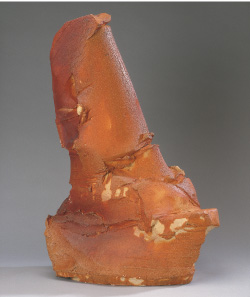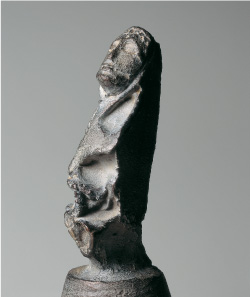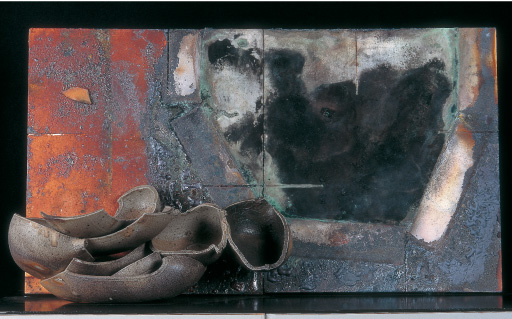2.Ceramic art
In 1983, at the age of forty-nine, Ikeda became enthralled by ceramic art, going beyond the conventional concept to produce a succession of ceramics in the style of the open-fired rope-pattern pottery of Japan’s prehistoric Jomon Period. In his printmaking, Ikeda had consciously eliminated influences from Ukiyo-e prints, devoting himself to Western styles of art, but on commencing to work with ceramics, his approach changed, and his interest in the traditional forms of Japan grew. That change can also be seen in his printmaking, as he actively incorporated forms employed by artists such as Sotatsu and Korin, transforming the style of his prints. Ikeda described his new interest in ceramics as a “return to Japan,” and two years before his death, he began to work on his Heart Sutra series.
One of the characteristics of the ceramic works that Ikeda produced in his final years was that they were deliberately designed to break. He talked about the “aesthetics of destruction,” and gained a reputation as the only ceramicist selling broken works. Ragyo / Akane-jo (1993) is notable for the beautiful colouring achieved. And Kabe / Kamigami no Utsuwa (1995), which incorporates a kiln shelf, is a work that no-one in the traditional ceramic art world would have thought of. The Heart Sutra series was inspired by a Kyoto publisher suggesting that Ikeda use the sutra as a theme for a series of prints that could be published as a book. Ikeda took up the idea, but settled on ceramic sculptures rather than prints. The results are considered to be the greatest of his ceramic art works.
 |
|
 |
Ragyo / Akane-jo
stoneware 1993 |
|
Jizo 16
bronze 1994
|
 |
Kabe / Kamigami no Utsuwa
stoneware 1995
[shown for the first time ever] |
|
![]()